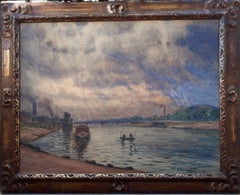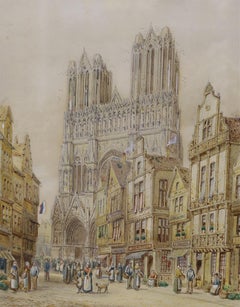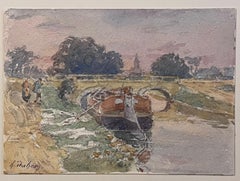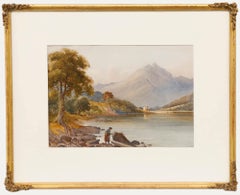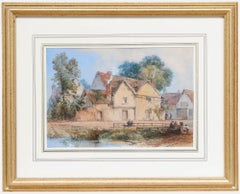19th Century Landscape Drawings and Watercolors
French School 19th Century Landscape Drawings and Watercolors
Watercolor, Gouache, Laid Paper
Realist 19th Century Landscape Drawings and Watercolors
Watercolor
Realist 19th Century Landscape Drawings and Watercolors
Watercolor, Gouache, Archival Paper
Impressionist 19th Century Landscape Drawings and Watercolors
Gouache
19th Century Landscape Drawings and Watercolors
Watercolor
19th Century Landscape Drawings and Watercolors
Watercolor
Romantic 19th Century Landscape Drawings and Watercolors
Laid Paper, Pencil
Post-Impressionist 19th Century Landscape Drawings and Watercolors
Watercolor
Impressionist 19th Century Landscape Drawings and Watercolors
Watercolor, Laid Paper
19th Century Landscape Drawings and Watercolors
Watercolor
Victorian 19th Century Landscape Drawings and Watercolors
Paper, Watercolor
Naturalistic 19th Century Landscape Drawings and Watercolors
Charcoal, Archival Paper
19th Century Landscape Drawings and Watercolors
Watercolor
Academic 19th Century Landscape Drawings and Watercolors
Watercolor
Victorian 19th Century Landscape Drawings and Watercolors
Paper, Watercolor
19th Century Landscape Drawings and Watercolors
Watercolor
19th Century Landscape Drawings and Watercolors
Watercolor
19th Century Landscape Drawings and Watercolors
Paper, Watercolor
Modern 19th Century Landscape Drawings and Watercolors
Oil, Watercolor
Impressionist 19th Century Landscape Drawings and Watercolors
Gouache
19th Century Landscape Drawings and Watercolors
Watercolor
American Realist 19th Century Landscape Drawings and Watercolors
Watercolor, Gouache
19th Century Landscape Drawings and Watercolors
Watercolor
19th Century Landscape Drawings and Watercolors
Realist 19th Century Landscape Drawings and Watercolors
Engraving
19th Century Landscape Drawings and Watercolors
Watercolor
Tonalist 19th Century Landscape Drawings and Watercolors
Watercolor
American Realist 19th Century Landscape Drawings and Watercolors
Archival Paper, Graphite
English School 19th Century Landscape Drawings and Watercolors
Handmade Paper, Pencil
19th Century Landscape Drawings and Watercolors
Watercolor
English School 19th Century Landscape Drawings and Watercolors
Crayon, Handmade Paper
Other Art Style 19th Century Landscape Drawings and Watercolors
Silk, Watercolor
Romantic 19th Century Landscape Drawings and Watercolors
Graphite
19th Century Landscape Drawings and Watercolors
Paper, Crayon, Pastel
19th Century Landscape Drawings and Watercolors
Watercolor
Victorian 19th Century Landscape Drawings and Watercolors
Watercolor
Academic 19th Century Landscape Drawings and Watercolors
Watercolor, Paper
19th Century Landscape Drawings and Watercolors
Watercolor
19th Century Landscape Drawings and Watercolors
Watercolor
Modern 19th Century Landscape Drawings and Watercolors
Watercolor
19th Century Landscape Drawings and Watercolors
Watercolor, Gouache
Impressionist 19th Century Landscape Drawings and Watercolors
Gouache
19th Century Landscape Drawings and Watercolors
Watercolor
19th Century Landscape Drawings and Watercolors
Watercolor
19th Century Landscape Drawings and Watercolors
Watercolor
19th Century Landscape Drawings and Watercolors
Watercolor
American Impressionist 19th Century Landscape Drawings and Watercolors
Paper, Watercolor
19th Century Landscape Drawings and Watercolors
Watercolor
Modern 19th Century Landscape Drawings and Watercolors
Ink, Pencil
Post-Impressionist 19th Century Landscape Drawings and Watercolors
Watercolor
Modern 19th Century Landscape Drawings and Watercolors
Paper, Charcoal
Academic 19th Century Landscape Drawings and Watercolors
Charcoal, Paper
Realist 19th Century Landscape Drawings and Watercolors
Pencil
Realist 19th Century Landscape Drawings and Watercolors
Ink, Handmade Paper, Graphite
Impressionist 19th Century Landscape Drawings and Watercolors
Paper, Watercolor
19th Century Landscape Drawings and Watercolors
Watercolor
English School 19th Century Landscape Drawings and Watercolors
Paper, Watercolor, Pencil
19th Century Landscape Drawings and Watercolors
Watercolor
19th Century Landscape Drawings and Watercolors
Watercolor
Italian School 19th Century Landscape Drawings and Watercolors
Watercolor, Laid Paper
